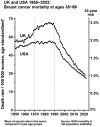Understanding global variation in breast cancer mortality
- PMID: 40608527
- PMCID: PMC12377464
- DOI: 10.1093/bjr/tqaf148
Understanding global variation in breast cancer mortality
Abstract
Breast cancer is an important global health challenge. Among women, it is the most commonly diagnosed cancer and the leading cause of cancer-related mortality. There are significant variations in the incidence and mortality rates globally with highest incidence and lowest mortality observed in more developed countries. The number of women diagnosed with breast cancer is projected to rise to ∼3 million annual cases by 2050 from ∼2 million in 2022, and the number of breast cancer-related deaths is projected to rise to over 1 million by 2050 from ∼660 000 in 2022. The largest increases in both incidence and mortality will be in less developed regions of the world. Over the last 40 years, significant gains have been made in reducing breast cancer mortality in more developed countries, but significant challenges remain in tackling the less favourable mortality rates in less developed countries. In this article, we discuss the global variation in breast cancer mortality rates. We used Sudan to present a case study of the devastating impact of conflict on cancer care.
Keywords: breast cancer; cancer care; conflict; global health; mortality.
© The Author(s) 2025. Published by Oxford University Press on behalf of the British Institute of Radiology.
Conflict of interest statement
The authors declare no conflict of interest.
Figures


References
-
- Bray F, Laversanne M, Sung H, et al. Global Cancer Statistics 2022: GLOBOCAN estimates of incidence and mortality worldwide for 36 cancers in 185 countries. CA Cancer J Clin. 2024;74:229-263. - PubMed
-
- Kim J, Harper A, McCormack V, et al. Global patterns and trends in breast cancer incidence and mortality across 185 countries. Nat Med. 2025;31:1154-1162. - PubMed
-
- Heer E, Harper A, Escandor N, Sung H, McCormack V, Fidler-Benaoudia MM. Global burden and trends in premenopausal and postmenopausal breast cancer: a population-based study. Lancet Glob Health. 2020;8:e1027-e1037. - PubMed
MeSH terms
Grants and funding
LinkOut - more resources
Full Text Sources
Medical

